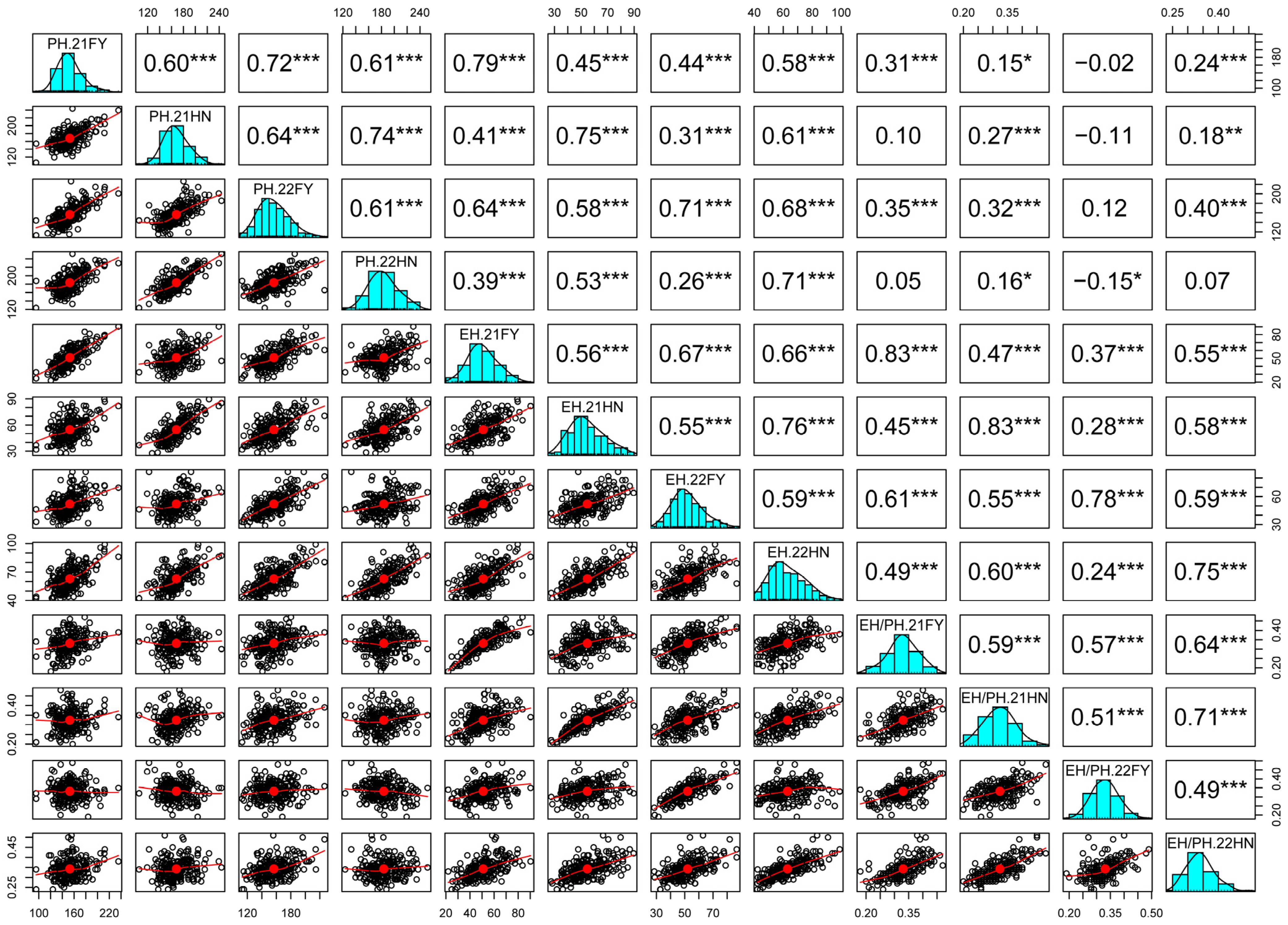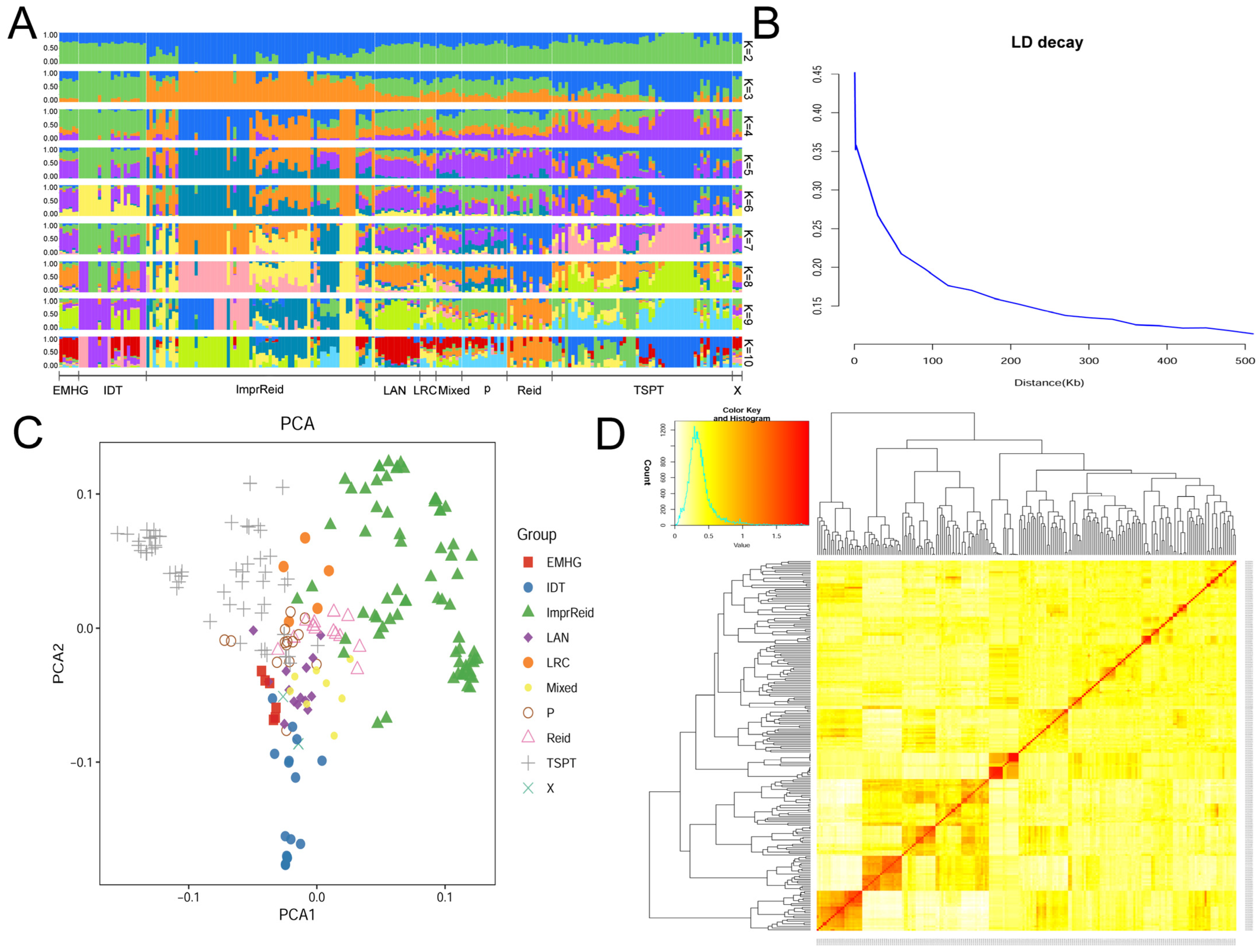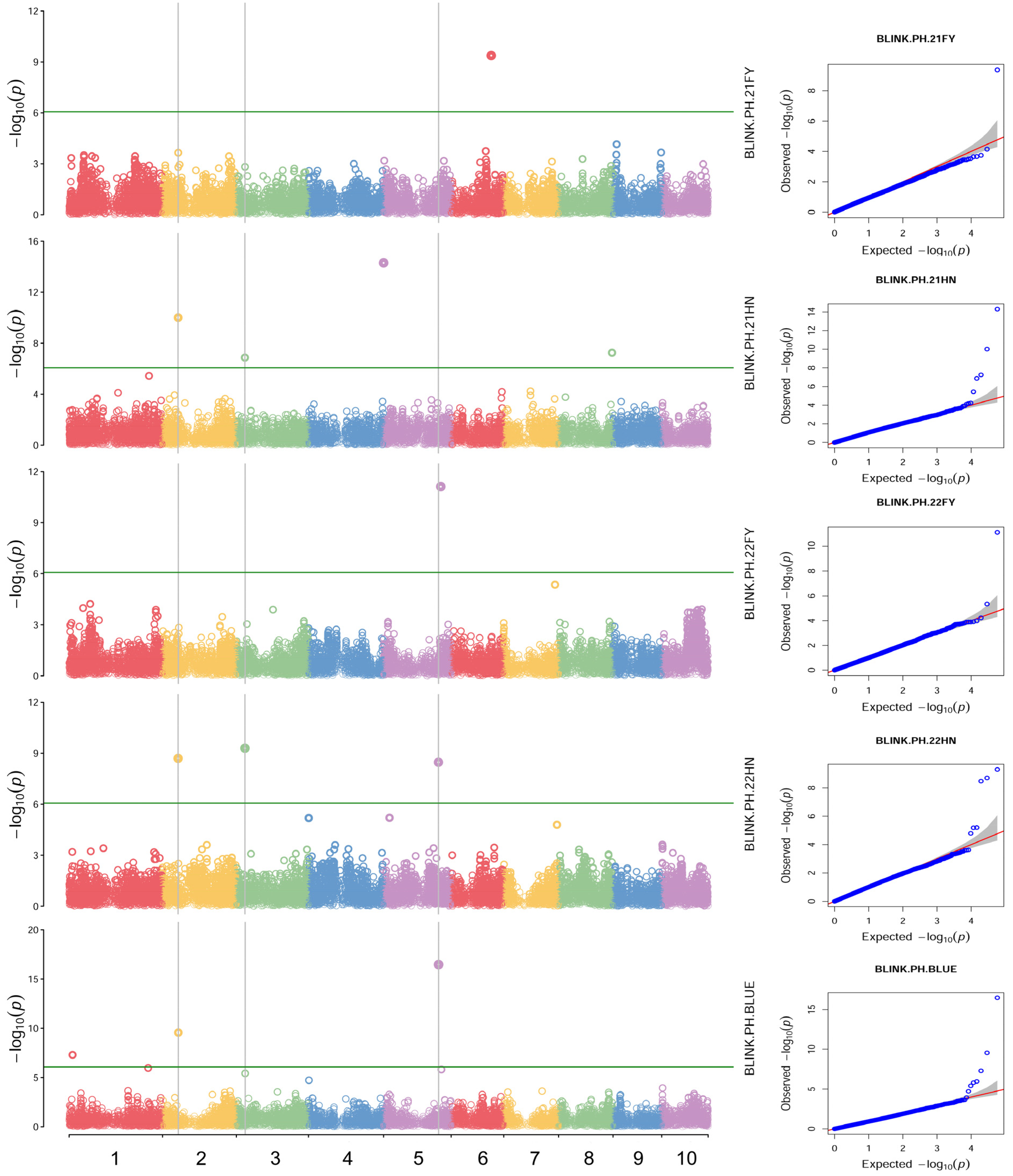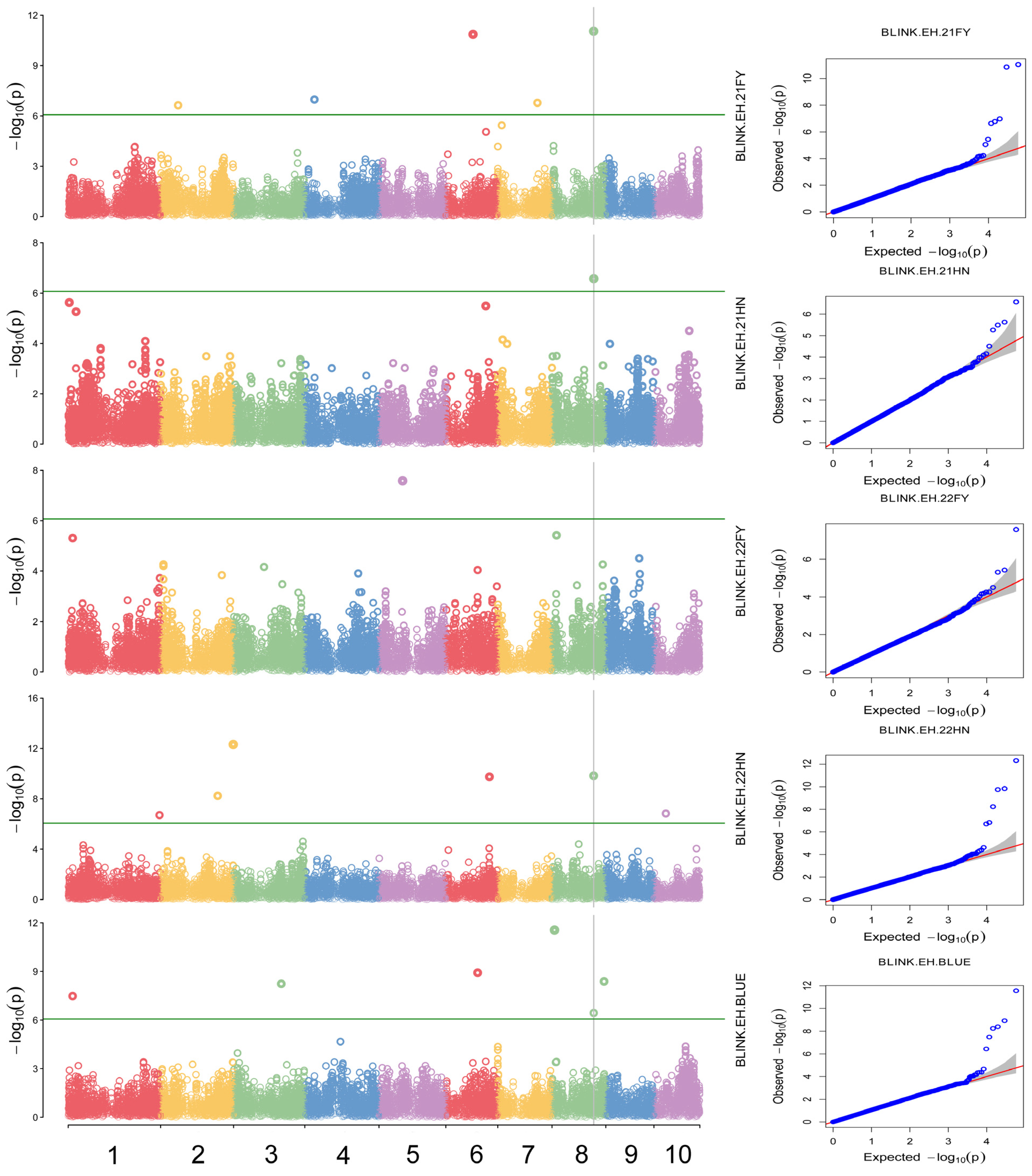Genetic Diversity Analysis and GWAS of Plant Height and Ear Height in Maize Inbred Lines from South-East China
Abstract
1. Introduction
2. Results
2.1. Analysis of Plant-Type Traits and Phenotypes
2.2. Correlation Analysis of Plant-Type Traits
2.3. Population Structure and Kinship Analysis
2.4. Genome-Wide Association Analysis
2.5. Candidate Gene Analysis
2.6. Effect Analysis of Allelic Variation
3. Discussion
3.1. The Significance of PH and EH in Maize
3.2. Analysis of the Stable QTL in the Population
3.3. A Comprehensive Analysis of Candidate Genes Prediction of the Stable QTL Interval in Maize
4. Materials and Methods
4.1. Plant Materials
4.2. Field Experiment and Phenotypic Measurements
4.3. DNA Extraction and Genotype Detection
4.4. Population Structure and Linkage Disequilibrium (LD) Analysis
4.5. Genome-Wide Association Study
4.6. Functional Annotation of Candidate Genes
5. Conclusions
Supplementary Materials
Author Contributions
Funding
Data Availability Statement
Acknowledgments
Conflicts of Interest
Abbreviations
References
- Stevens, T.; Madani, K. Future climate impacts on maize farming and food security in Malawi. Sci. Rep. 2016, 6, 36241. [Google Scholar] [CrossRef] [PubMed]
- Ray, D.K.; Mueller, N.D.; West, P.C.; Foley, J.A. Yield Trends Are Insufficient to Double Global Crop Production by 2050. PLoS ONE 2013, 8, e66428. [Google Scholar] [CrossRef] [PubMed]
- Wang, B.; Lin, Z.; Li, X.; Zhao, Y.; Zhao, B.; Wu, G.; Ma, X.; Wang, H.; Xie, Y.; Li, Q.; et al. Genome-wide selection and genetic improvement during modern maize breeding. Nat. Genet. 2020, 52, 565–571. [Google Scholar] [CrossRef] [PubMed]
- Zhao, Y.; Huang, Y.; Gao, Y.; Wang, Y.; Wu, H.; Zhu, H.; Lu, X.; Ma, Q. An EMS-induced allele of the brachytic2 gene can reduce plant height in maize. Plant Cell Rep. 2023, 42, 749–761. [Google Scholar] [CrossRef] [PubMed]
- Peiffer, J.A.; Romay, M.C.; Gore, M.A.; Flint-Garcia, S.A.; Zhang, Z.; Millard, M.J.; Gardner, C.A.; McMullen, M.D.; Holland, J.B.; Bradbury, P.J.; et al. The genetic architecture of maize height. Genetics 2014, 196, 1337–1356. [Google Scholar] [CrossRef]
- Wang, B.; Liu, H.; Liu, Z.; Dong, X.; Guo, J.; Li, W.; Chen, J.; Gao, C.; Zhu, Y.; Zheng, X.; et al. Identification of minor effect QTLs for plant architecture related traits using super high density genotyping and large recombinant inbred population in maize (Zea mays). BMC Plant Biol. 2018, 18, 17. [Google Scholar] [CrossRef]
- Pan, Q.; Xu, Y.; Li, K.; Peng, Y.; Zhan, W.; Li, W.; Li, L.; Yan, J. The Genetic Basis of Plant Architecture in 10 Maize Recombinant Inbred Line Populations. Plant Physiol. 2017, 175, 858–873. [Google Scholar] [CrossRef]
- Wang, T.Y.; Wang, R.H.; Wang, X.Q.; Zhang, R.Y.; Xu, R.B.; Jiao, Y.Y.; Sun, X.; Wang, J.D.; Song, W.; Zhao, J.R. Research in Maize Dwarf Genes and Dwarf Breeding. Biotechnol. Bull. 2023, 39, 43–51. [Google Scholar]
- Bensen, R.J.; Johal, G.S.; Crane, V.C.; Tossberg, J.T.; Schnable, P.S.; Meeley, R.B.; Briggs, S.P. Cloning and characterization of the maize An1 gene. Plant cell 1995, 7, 75–84. [Google Scholar]
- Harris, L.J.; Saparno, A.; Johnston, A.; Prisic, S.; Xu, M.; Allard, S.; Kathiresan, A.; Ouellet, T.; Peters, R.J. The maize An2 gene is induced by Fusarium attack and encodes an entcopalyl diphosphate synthase. Plant Mol. Biol. 2005, 59, 881–894. [Google Scholar] [CrossRef]
- Bommert, P.; Je, B.I.; Goldshmidt, A.; Jackson, D. The maize Galpha gene COMPACT PLANT2 functions in CLAVATA signalling to control shoot meristem size. Nature 2013, 502, 555–558. [Google Scholar] [CrossRef] [PubMed]
- Chen, Y.; Hou, M.; Liu, L.; Wu, S.; Shen, Y.; Ishiyama, K.; Kobayashi, M.; McCarty, D.R.; Tan, B.C. The maize DWARF1 encodes a gibberellin 3-oxidase and is dual localized to the nucleus and cytosol. Plant Physiol. 2014, 166, 2028–2039. [Google Scholar] [CrossRef] [PubMed]
- Fujioka, S.; Yamane, H.; Spray, C.R.; Gaskin, P.; Macmillan, J.; Phinney, B.O.; Takahashi, N. Qualitative and Quantitative Analyses of Gibberellins in Vegetative Shoots of Normal, dwarf-1, dwarf-2, dwarf-3, and dwarf-5 Seedlings of Zea mays L. Plant Physiol. 1988, 88, 1367–1372. [Google Scholar] [CrossRef] [PubMed]
- Winkler, R.G.; Helentjaris, T. The maize Dwarf3 gene encodes a cytochrome P450-mediated early step in Gibberellin biosynthesis. Plant Cell 1995, 7, 1307–1317. [Google Scholar]
- Lawit, S.J.; Wych, H.M.; Xu, D.; Kundu, S.; Tomes, D.T. Maize DELLA proteins dwarf plant8 and dwarf plant9 as modulators of plant development. Plant Cell Physiol. 2010, 51, 1854–1868. [Google Scholar] [CrossRef]
- Cassani, E.; Bertolini, E.; Cerino Badone, F.; Landoni, M.; Gavina, D.; Sirizzotti, A.; Pilu, R. Characterization of the first dominant dwarf maize mutant carrying a single amino acid insertion in the VHYNP domain of the dwarf8 gene. Mol. Breed. 2009, 24, 375–385. [Google Scholar] [CrossRef]
- Wang, Y.; Deng, D.; Ding, H.; Xu, X.; Zhang, R.; Wang, S.; Bian, Y.; Yin, Z.; Chen, Y. Gibberellin biosynthetic deficiency is responsible for maize dominant Dwarf11 (D11) mutant phenotype: Physiological and transcriptomic evidence. PLoS ONE 2013, 8, e66466. [Google Scholar] [CrossRef]
- Yamaguchi, I.; Nakajima, M.; Park, S.H. Trails to the gibberellin receptor, GIBBERELLIN INSENSITIVE DWARF1. Biosci. Biotechnol. Bioch. 2016, 80, 1029–1036. [Google Scholar] [CrossRef][Green Version]
- Bolduc, N.; Hake, S. The maize transcription factor KNOTTED1 directly regulates the gibberellin catabolism gene ga2ox1. Plant Cell 2009, 21, 1647–1658. [Google Scholar] [CrossRef]
- Avila, L.M.; Cerrudo, D.; Swanton, C.; Lukens, L. Brevis plant1, a putative inositol polyphosphate 5-phosphatase, is required for internode elongation in maize. J. Exp. Bot. 2016, 67, 1577–1588. [Google Scholar] [CrossRef]
- Wang, F.; Yu, Z.; Zhang, M.; Wang, M.; Lu, X.; Liu, X.; Li, Y.; Zhang, X.; Tan, B.C.; Li, C.; et al. ZmTE1 promotes plant height by regulating intercalary meristem formation and internode cell elongation in maize. Plant Biotechnol. J. 2022, 20, 526–537. [Google Scholar] [CrossRef] [PubMed]
- Phillips, K.A.; Skirpan, A.L.; Liu, X.; Christensen, A.; Slewinski, T.L.; Hudson, C.; Barazesh, S.; Cohen, J.D.; Malcomber, S.; McSteen, P. vanishing tassel2 encodes a grass-specific tryptophan aminotransferase required for vegetative and reproductive development in maize. Plant Cell 2011, 23, 550–566. [Google Scholar] [CrossRef] [PubMed]
- Li, Z.; Zhang, X.; Zhao, Y.; Li, Y.; Zhang, G.; Peng, Z.; Zhang, J. Enhancing auxin accumulation in maize root tips improves root growth and dwarfs plant height. Plant Biotechnol. J. 2018, 16, 86–99. [Google Scholar] [CrossRef] [PubMed]
- Makarevitch, I.; Thompson, A.; Muehlbauer, G.J.; Springer, N.M. Brd1 gene in maize encodes a brassinosteroid C-6 oxidase. PLoS ONE 2012, 7, e30798. [Google Scholar] [CrossRef]
- Kir, G.; Ye, H.; Nelissen, H.; Neelakandan, A.K.; Kusnandar, A.S.; Luo, A.; Inze, D.; Sylvester, A.W.; Yin, Y.; Becraft, P.W. RNA Interference Knockdown of BRASSINOSTEROID INSENSITIVE1 in Maize Reveals Novel Functions for Brassinosteroid Signaling in Controlling Plant Architecture. Plant Physiol. 2015, 169, 826–839. [Google Scholar] [CrossRef]
- Castorina, G.; Persico, M.; Zilio, M.; Sangiorgio, S.; Carabelli, L.; Consonni, G. The maize lilliputian1 (lil1) gene, encoding a brassinosteroid cytochrome P450 C-6 oxidase, is involved in plant growth and drought response. Ann. Bot. 2018, 122, 227–238. [Google Scholar] [CrossRef]
- Hartwig, T.; Chuck, G.S.; Fujioka, S.; Klempien, A.; Weizbauer, R.; Potluri, D.P.; Choe, S.; Johal, G.S.; Schulz, B. Brassinosteroid control of sex determination in maize. Proc. Natl. Acad. Sci. USA 2011, 108, 19814–19819. [Google Scholar] [CrossRef]
- Best, N.B.; Hartwig, T.; Budka, J.; Fujioka, S.; Johal, G.; Schulz, B.; Dilkes, B.P. nana plant2 Encodes a Maize Ortholog of the Arabidopsis Brassinosteroid Biosynthesis Gene DWARF1, Identifying Developmental Interactions between Brassinosteroids and Gibberellins. Plant Physiol. 2016, 171, 2633–2647. [Google Scholar] [CrossRef]
- Li, H.; Wang, L.; Liu, M.; Dong, Z.; Li, Q.; Fei, S.; Xiang, H.; Liu, B.; Jin, W. Maize Plant Architecture Is Regulated by the Ethylene Biosynthetic Gene ZmACS7. Plant Physiol. 2020, 183, 1184–1199. [Google Scholar] [CrossRef]
- Guan, J.C.; Koch, K.E.; Suzuki, M.; Wu, S.; Latshaw, S.; Petruff, T.; Goulet, C.; Klee, H.J.; McCarty, D.R. Diverse roles of strigolactone signaling in maize architecture and the uncoupling of a branching-specific subnetwork. Plant Physiol. 2012, 160, 1303–1317. [Google Scholar] [CrossRef]
- Li, W.; Ge, F.; Qiang, Z.; Zhu, L.; Zhang, S.; Chen, L.; Wang, X.; Li, J.; Fu, Y. Maize ZmRPH1 encodes a microtubule-associated protein that controls plant and ear height. Plant Biotechnol. J. 2020, 18, 1345–1347. [Google Scholar] [CrossRef] [PubMed]
- Li, Q.; Wu, G.; Zhao, Y.; Wang, B.; Zhao, B.; Kong, D.; Wei, H.; Chen, C.; Wang, H. CRISPR/Cas9-mediated knockout and overexpression studies reveal a role of maize phytochrome C in regulating flowering time and plant height. Plant Biotechnol. J. 2020, 18, 2520–2532. [Google Scholar] [CrossRef] [PubMed]
- Lv, H.; Zheng, J.; Wang, T.; Fu, J.; Huai, J.; Min, H.; Zhang, X.; Tian, B.; Shi, Y.; Wang, G. The maize d2003, a novel allele of VP8, is required for maize internode elongation. Plant Mol. Biol. 2014, 84, 243–257. [Google Scholar] [CrossRef] [PubMed]
- Khan, M.K.; Pandey, A.; Hamurcu, M.; Vyhnánek, T.; Zargar, S.M.; Kahraman, A.; Topal, A.; Gezgin, S. Exploring strigolactones for inducing abiotic stress tolerance in plants. Czech J. Genet. Plant Breed. 2024, 60, 55–69. [Google Scholar] [CrossRef]
- Zhao, B.; Xia, Z.; Sun, C.; Yang, D.; Zhao, Y.; Cao, J.; Li, Y.; Wang, H.; Wang, B. CRISPR/Cas9-mediated genomic editing of Brachytic2 creates semi-dwarf mutant alleles for tailored maize breeding. Plant Biotechnol. J. 2025, 1–3. [Google Scholar] [CrossRef]
- Zhou, Z.; Zhang, C.; Lu, X.; Wang, L.; Hao, Z.; Li, M.; Zhang, D.; Yong, H.; Zhu, H.; Weng, J.; et al. Dissecting the Genetic Basis Underlying Combining Ability of Plant Height Related Traits in Maize. Front. Plant Sci. 2018, 9, 1117. [Google Scholar] [CrossRef]
- Luo, Z.; Wu, L.; Miao, X.; Zhang, S.; Wei, N.; Zhao, S.; Shang, X.; Hu, H.; Xue, J.; Zhang, T.; et al. A dynamic regulome of shoot-apical-meristem-related homeobox transcription factors modulates plant architecture in maize. Genome Biol. 2024, 25, 245. [Google Scholar] [CrossRef]
- Yuen, C.Y.; Shek, R.; Kang, B.H.; Matsumoto, K.; Cho, E.J.; Christopher, D.A. Arabidopsis protein disulfide isomerase-8 is a type I endoplasmic reticulum transmembrane protein with thiol-disulfide oxidase activity. BMC Plant Biol. 2016, 16, 181. [Google Scholar] [CrossRef][Green Version]
- Li, J.; Zhang, Y.; Li, Z.; Dai, H.; Luan, X.; Zhong, T.; Chen, S.; Xie, X.M.; Qin, G.; Zhang, X.Q.; et al. OsPEX1, an extensin-like protein, negatively regulates root growth in a gibberellin-mediated manner in rice. Plant Mol. Biol. 2023, 112, 47–59. [Google Scholar] [CrossRef]
- Xi, W.; Liu, C.; Hou, X.; Yu, H. MOTHER OF FT AND TFL1 regulates seed germination through a negative feedback loop modulating ABA signaling in Arabidopsis. Plant Cell 2010, 22, 1733–1748. [Google Scholar] [CrossRef]
- Wu, J.; Tan, X.; Wu, C.; Cao, K.; Li, Y.; Bao, Y. Regulation of cytokinesis by exocyst subunit SEC6 and KEULE in Arabidopsis thaliana. Mol. Plant 2013, 6, 1863–1876. [Google Scholar] [CrossRef]
- Yu, L.H.; Miao, Z.Q.; Qi, G.F.; Wu, J.; Cai, X.T.; Mao, J.L.; Xiang, C.B. MADS-box transcription factor AGL21 regulates lateral root development and responds to multiple external and physiological signals. Mol. Plant 2014, 7, 1653–1669. [Google Scholar] [CrossRef] [PubMed]
- Howden, R.; Goldsbrough, P.B.; Andersen, C.R.; Cobbett, C.S. Cadmium-sensitive, cad1 mutants of Arabidopsis thaliana are phytochelatin deficient. Plant Physiol. 1995, 107, 1059–1066. [Google Scholar] [CrossRef] [PubMed]
- Wu, Y.; Chang, Y.; Luo, L.; Tian, W.; Gong, Q.; Liu, X. Abscisic acid employs NRP-dependent PIN2 vacuolar degradation to suppress auxin-mediated primary root elongation in Arabidopsis. New Phytol. 2022, 233, 297–312. [Google Scholar] [CrossRef] [PubMed]
- Zhou, H.; Zhao, J.; Cai, J.; Patil, S.B. UBIQUITIN-SPECIFIC PROTEASES function in plant development and stress responses. Plant Mol. Biol. 2017, 94, 565–576. [Google Scholar] [CrossRef] [PubMed]
- Moon, Y.K.; Hong, J.P.; Cho, Y.C.; Yang, S.J.; An, G.; Kim, W.T. Structure and expression of OsUBP6, an ubiquitin-specific protease 6 homolog in rice (Oryza sativa L.). Mol. Cells 2009, 28, 463–472. [Google Scholar] [CrossRef]
- Ganguly, A.; Zhu, C.; Chen, W.; Dixit, R. FRA1 Kinesin Modulates the Lateral Stability of Cortical Microtubules through Cellulose Synthase-Microtubule Uncoupling Proteins. Plant Cell 2020, 32, 2508–2524. [Google Scholar] [CrossRef]
- Caro, E.; Stroud, H.; Greenberg, M.V.; Bernatavichute, Y.V.; Feng, S.; Groth, M.; Vashisht, A.A.; Wohlschlegel, J.; Jacobsen, S.E. The SET-domain protein SUVR5 mediates H3K9me2 deposition and silencing at stimulus response genes in a DNA methylation-independent manner. PLoS Genet. 2012, 8, e1002995. [Google Scholar] [CrossRef]
- Mo, X.; Zhu, Q.; Li, X.; Li, J.; Zeng, Q.; Rong, H.; Zhang, H.; Wu, P. The hpa1 mutant of Arabidopsis reveals a crucial role of histidine homeostasis in root meristem maintenance. Plant Physiol. 2006, 141, 1425–1435. [Google Scholar] [CrossRef]
- Li, S.; Deng, B.; Tian, S.; Guo, M.; Liu, H.; Zhao, X. Metabolic and transcriptomic analyses reveal different metabolite biosynthesis profiles between leaf buds and mature leaves in Ziziphus jujuba mill. Food Chem. 2021, 347, 129005. [Google Scholar] [CrossRef]
- Chen, L.; He, W.; Yu, Y.; Wang, Y.; Zhai, X.; Ling, X.; Lu, P.; Cheng, X.; Lei, W.; Fan, Z. Molecular mapping and candidate gene identification of two major quantitative trait loci associated with silique length in oilseed rape (Brassica napus L.). Mol. Breed. 2024, 44, 26. [Google Scholar] [CrossRef] [PubMed]
- Merk, H.L.; Yarnes, S.C.; Van Deynze, A.; Tong, N.; Menda, N.; Mueller, L.A.; Mutschler, M.A.; Loewen, S.A.; Myers, J.R.; Francis, D.M. Trait Diversity and Potential for Selection Indices Based on Variation Among Regionally Adapted Processing Tomato Germplasm. J. Amer. Soc. Hortic. Sci. 2012, 137, 427–437. [Google Scholar] [CrossRef]
- Doyle, J.J.; Doyle, J.L. A rapid DNA isolation procedure for small quantities of fresh leaf tissue. Phytochem. Bull. 1987, 19, 11–15. [Google Scholar]
- Alexander, D.H.; Novembre, J.; Lange, K. Fast model-based estimation of ancestry in unrelated individuals. Genome Res. 2009, 19, 1655–1664. [Google Scholar] [CrossRef] [PubMed]
- Tian, H.; Yang, Y.; Yi, H.; Xu, L.; He, H.; Fan, Y.; Wang, L.; Ge, J.; Liu, Y.; Wang, F.; et al. New resources for genetic studies in maize (Zea mays L.): A genome-wide Maize6H-60K single nucleotide polymorphism array and its application. Plant J. 2021, 105, 1113–1122. [Google Scholar] [CrossRef]
- He, Z.; Zhang, H.; Gao, S.; Lercher, M.J.; Chen, W.H.; Hu, S. Evolview v2: An online visualization and management tool for customized and annotated phylogenetic trees. Nucleic Acids Res. 2016, 44, W236–W241. [Google Scholar] [CrossRef]
- Huang, M.; Liu, X.; Zhou, Y.; Summers, R.M.; Zhang, Z. BLINK: A package for the next level of genome-wide association studies with both individuals and markers in the millions. Gigascience 2019, 8, giy154. [Google Scholar] [CrossRef]
- Wang, J.; Zhang, Z. GAPIT Version 3: Boosting Power and Accuracy for Genomic Association and Prediction. Genom. Proteom. Bioinf. 2021, 19, 629–640. [Google Scholar] [CrossRef]








| Traits | Environment | Mean ± SEM | Range | CV/% | Skewness | Kurtosis | H2/% a |
|---|---|---|---|---|---|---|---|
| PH | 21FY | 152.68 ± 1.45 | 95.30–235.60 | 13.81 | 0.68 | 1.27 | 80.95 |
| 21HN | 168.11 ± 1.47 | 105.60–243.90 | 12.74 | 0.48 | 0.75 | ||
| 22FY | 156.54 ± 1.43 | 112.80–226.50 | 13.30 | 0.55 | 0.26 | ||
| 22HN | 183.66 ± 1.56 | 123.50–251.80 | 12.34 | 0.31 | −0.09 | ||
| EH | 21FY | 50.96 ± 0.84 | 21.88–90.25 | 24.12 | 0.38 | 0.09 | 80.97 |
| 21HN | 54.72 ± 0.88 | 27.60–89.60 | 23.41 | 0.46 | −0.30 | ||
| 22FY | 52.06 ± 0.76 | 28.50–86.70 | 21.31 | 0.59 | 0.33 | ||
| 22HN | 62.94 ± 0.81 | 42.10–99.00 | 18.77 | 0.52 | −0.17 | ||
| EH/PH | 21FY | 0.33 ± 0.00 | 0.18–0.47 | 16.12 | −0.15 | 0.06 | 79.87 |
| 21HN | 0.32 ± 0.00 | 0.20–0.48 | 16.45 | 0.21 | 0.01 | ||
| 22FY | 0.33 ± 0.00 | 0.19–0.49 | 14.85 | 0.21 | 0.43 | ||
| 22HN | 0.34 ± 0.00 | 0.24–0.51 | 13.40 | 0.63 | 0.92 |
| Traits | SNP | Chr | Position | p Value | PVE(%) a | Enviroment | Candidate Gene | Gene Annotation |
|---|---|---|---|---|---|---|---|---|
| PH | AX-108020973 | 2 | 50,805,562 | 2.73 × 10−10 | 7.42 | PH.22HN/ PH.BLUE | GRMZM2G113629 | Protein disulfide isomerase-like |
| AX-108022922 | 3 | 28,296,631 | 5.06 × 10−10 | 8.61 | PH.21HN/ PH.22HN | GRMZM2G375249 | Extensin-like protein | |
| GRMZM2G076029 | Leucine-rich repeat extensin-like protein 3 | |||||||
| GRMZM2G152689 | Phosphatidyl ethanol amine-binding protein | |||||||
| AX-247241325 | 5 | 177,277,477 | 3.39 × 10−17 | 7.70 | PH.22HN/ PH.BLUE | GRMZM2G099989 | Exocyst complex component SEC6 | |
| GRMZM2G316366 | Encodes a MADS box protein | |||||||
| GRMZM2G492156 | MADS-box transcription factor | |||||||
| AC210598.3_FG003 | Phytochelatin synthase 1(PCS1) | |||||||
| EH | AX-108097244 | 8 | 135,948,728 | 2.68 × 10−7 | 38.49 | EH.21FY/ EH.21HN/ EH.22HN/ EH.BLUE | GRMZM2G464754 | WD-40 repeat family protein |
| AC207342.3_FG008 | DCD domain protein | |||||||
| GRMZM2G028733 | Ubiquitin-specific protease 7 | |||||||
| EH/PH | AX-108096437 | 5 | 201,653,556 | 2.69 × 10−9 | 6.23 | EH/PH.21FY/ EH/PH.BLUE | GRMZM2G147377 | Lateral stability of cortical microtubules |
| GRMZM2G125432 | DNA binding transcription factors | |||||||
| GRMZM2G170595 | Histidinol phosphate aminotransferase 1 |
Disclaimer/Publisher’s Note: The statements, opinions and data contained in all publications are solely those of the individual author(s) and contributor(s) and not of MDPI and/or the editor(s). MDPI and/or the editor(s) disclaim responsibility for any injury to people or property resulting from any ideas, methods, instructions or products referred to in the content. |
© 2025 by the authors. Licensee MDPI, Basel, Switzerland. This article is an open access article distributed under the terms and conditions of the Creative Commons Attribution (CC BY) license (https://creativecommons.org/licenses/by/4.0/).
Share and Cite
Wang, C.; He, W.; Li, K.; Yu, Y.; Zhang, X.; Yang, S.; Wang, Y.; Yu, L.; Huang, W.; Yu, H.; et al. Genetic Diversity Analysis and GWAS of Plant Height and Ear Height in Maize Inbred Lines from South-East China. Plants 2025, 14, 481. https://doi.org/10.3390/plants14030481
Wang C, He W, Li K, Yu Y, Zhang X, Yang S, Wang Y, Yu L, Huang W, Yu H, et al. Genetic Diversity Analysis and GWAS of Plant Height and Ear Height in Maize Inbred Lines from South-East China. Plants. 2025; 14(3):481. https://doi.org/10.3390/plants14030481
Chicago/Turabian StyleWang, Changjin, Wangfei He, Keyu Li, Yulin Yu, Xueshi Zhang, Shuo Yang, Yongfu Wang, Li Yu, Weidong Huang, Haibing Yu, and et al. 2025. "Genetic Diversity Analysis and GWAS of Plant Height and Ear Height in Maize Inbred Lines from South-East China" Plants 14, no. 3: 481. https://doi.org/10.3390/plants14030481
APA StyleWang, C., He, W., Li, K., Yu, Y., Zhang, X., Yang, S., Wang, Y., Yu, L., Huang, W., Yu, H., Chen, L., & Cheng, X. (2025). Genetic Diversity Analysis and GWAS of Plant Height and Ear Height in Maize Inbred Lines from South-East China. Plants, 14(3), 481. https://doi.org/10.3390/plants14030481






